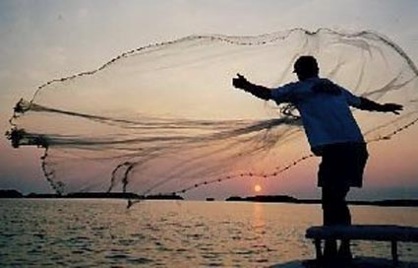
You always come home with fish if you’re a castnetter
Throwing Your Trouble Away
I love cast netting. I own five of them and when fishing rarely come home empty handed. I also never throw for bait: I go for the full-grown fish.
Here in Florida whatever saltwater fish I can catch with a line and hook I can catch with a cast net (check your local laws as they vary.) What is amazing is the attitude fishermen have about cast nets. Just as most folks never view weeds as food, most fishermen never view cast nests as something you catch big fish with. Frankly, that is all I catch with my cast nets.
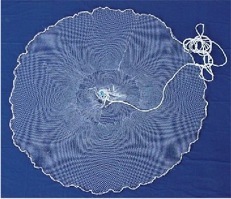
Cast nets have weights all around the skirt
Beyond fishing, throwing a cast net is good exercise. I throw right and left handed to not only balance the workout but to throw longer. Toss 10 to 20 pounds a 100 times and haul it in against the waves and you get a workout. I’ll admit that learning to throw takes some practice, but it’s not hard and you can get good at it. I can put my favorite net any place within 25 feet with a lightning, low-to-the-water fastball throw. I can even toss one from a kayak. To have the best success you have to know where you are throwing and what you are throwing for.
There are five variables with cast nets. 1) The diameter, which is how far across the net, such as 6-foot, 10-foot, 12-foot. 2) The size of the mesh (1/4 inch, 1/2 inch, one inch), (3) The weight (actually the size of the weights.) The next variable (4) is where you are throwing: Surf, shallows, pier/breaker/bridge, boat. And the last variable (5) is what kind of fish you are fishing for.
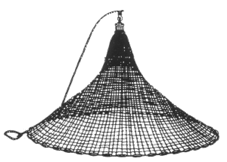
A cast net is an elaborate funnel
For example, if I am fishing in deep water off a a good-sized boat for large fish I want a large cast net with heavy weights and a large mesh. The heavy weights and large mesh maximizes how fast the net drops through the water (and air) and hopefully it drops faster than the fish can swim down before you close the net. The large distance across increases my chances of success. Further, little fish you are not interested in can swim through the mesh and not get caught. And although it is a heavy I am not tossing as much out as down, just past the boat.
If I am in shallow water looking for fast fish I want a medium mesh, light weights (because it doesn’t have to drop far to hit bottom, and a light net so I can throw it very quickly and low to get the fish before they see the flying net.
In medium surf I want a large mesh, heavy weights, but a net that’s not too big across or I will quickly tire myself out. The mesh and weight let it drop fast in the churning, cloudy water. It also lets bait fish escape and holds the big fish well.
And if on occasion I want bait I use a small net with small mesh, and medium weights. In shallow water, it drops fast and the mesh is so small the little fish get caught.
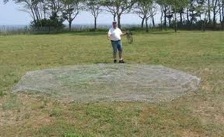
Practice on a lawn so you can see your pattern
The biggest threat to a net is the bottom, and barnacles on rocks. If I am fishing off a bridge here is probably trash on the bottom that can snag the net. So I either keep the net from hitting the bottom or I use an old net I don’t mind loosing. If I am fishing from a rocky break water I try to find a rock that allows me to pull my net up vertically. Barnacles catch nets like superglue and they can cut your hands when you try to get it free. So on breakwaters you might also want to consider using a net you wouldn’t miss.
As said earlier, when I fish with my cast net I never come home empty handed. I always catch something, even if it’s just a blue crab off the sandy bottom or edible jellyfish. But usually it is the objet du jour: Pompano, Mullet, Whiting, Sea bass, Flounder, Sheepshead, Stingrays, Crabs, Conch, and various little fish have all been caught in my net. I even caught a small dolphin once by mistake. Yes, I let it go. On days when the hook and sinker guys are just throwing their bait away I am catching supper. I think that is what sold me on cast nets some 40 years ago when I was poor and hungry: They work.
As for practice… you throw on a lawn, so you can see how you did, whether your throw is opening the net. There are several throwing techniques and you will find one that suits you best. It’s a rather personal. Most throw only one way and as long as it gets the net open which way really doesn’t matter. Essentially one hand throws the net, the other hand spins it making the net flare like a dress on a spinning dancer getting maximum coverage when it drops. I would urge you after you learn to throw on one side, learn to throw on the other. It makes you better, more versatile, and you catch more fish.
An interesting fact: Fish, the experts say, have no memory so they don’t remember you just tired to catch them with a cast net. Fishermen are perhaps similar. One finds cast nets regularly as fishermen tend to leave them behind. And if you don’t find one, they’re not expensive.
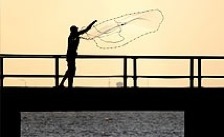
Cast netters are optimists
I have learned that game wardens, usually in federal parks, are not up on cast net laws. They are surprisingly uninformed. For example: Seine nets used on shore locally are illegal (because they work oh so well.) Cast nets are legal but wardens think all nets are illegal. If you have checked out the law — and it’s legal — and a game warden is about to write you a citation, ask him to write down the specific law he thinks you are breaking, by statute number. They usually don’t know so they call headquarters and they usually don’t know either because it really doesn’t exist. After much posturing they let you go. You win one and keep your fish.

